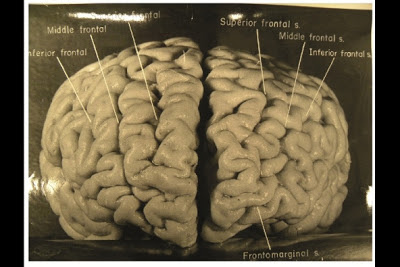Photographs taken shortly after his death, but never before analysed in
detail, have now revealed that Einstein’s brain had several unusual
features, providing clues about the neural basis of his
extraordinary mental abilities.
Nature.com reports that, while doing Einstein's autopsy, the pathologist Thomas Harvey removed
the physicist's brain and preserved it in formalin. He then took dozens
of black and white photographs of it before it was cut up into 240
blocks. Now, anthropologist Dean Falk of Florida State University in
Tallahassee and her colleagues have obtained 12 of Harvey’s original
photographs from the National Museum of Health and Medicine in Silver
Spring, Maryland, analysed them and compared the patterns of convoluted
ridges and furrows with those of 85 brains described in other studies.Many of the photographs were taken from unusual angles,
and show structures that were not visible in photographs that have been
analysed previously. The analysis was recently published today in the journal Brain. The most striking observation, says Falk, was “the
complexity and pattern of convolutions on certain parts of Einstein's
cerebral cortex”, especially in the prefrontal cortex, and also parietal
lobes and visual cortex.
I discuss issues pertaining to the practice of neuropathology -- including nervous system tumors, neuroanatomy, neurodegenerative disease, muscle and nerve disorders, ophthalmologic pathology, neuro trivia, neuropathology gossip, job listings and anything else that might be of interest to a blue-collar neuropathologist.
Subscribe to:
Post Comments (Atom)
Neuropathology Blog is Signing Off
Neuropathology Blog has run its course. It's been a fantastic experience authoring this blog over many years. The blog has been a source...
-
Neuropathology Blog has run its course. It's been a fantastic experience authoring this blog over many years. The blog has been a source...
-
A neuropathology colleague in Toronto (Dr. Phedias Diamandis) is developing some amazing AI-based tools for pathology and academia. He hel...


No comments:
Post a Comment